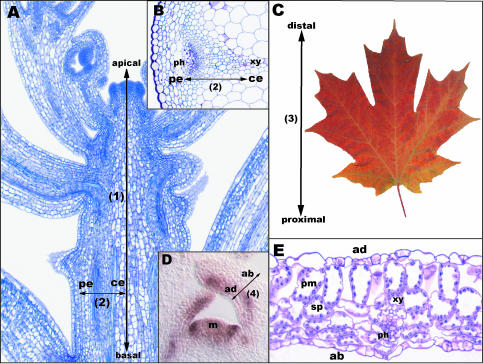Figure 1.
Four axes of development in seed plants. The apical-basal axis (1) of the plant represents a polarity established in embryogenesis with the shoot apical meristem being at the apical end and the root meristem residing at basal tip shown here in a longitudinal section of an Arabidopsis shoot (A). The other 3 axes depicted are defined with reference to this apical-basal axis. The central (ce)-peripheral (pe) axis (2) in the stem (B) is analogous to the adaxial (ad)-abaxial (ab) axis (4) of lateral organs (D) with the central/adaxial end being adjacent to the center of the shoot and the peripheral/abaxial end being away from the center of the shoot meristem (m). Lateral organs such as leaves also exhibit a proximal-distal axis (3) that can also be defined with respect to the stem, with the distal end away from the stem and the proximal end attached to the stem, as shown in the Acer leaf in C. Positions of tissues within vascular bundles develop with respect to the central-peripheral axis with the phloem (ph) positioned peripherally, the xylem (xy) positioned centrally in the stem (B), and the xylem positioned adaxially and phloem abaxially in lateral organs (E). In addition to polar differentiation of vascular tissues, leaf asymmetry is evident with palisade mesophyll (pm) differentiating adaxially and spongy mesophyll (sp) positioned abaxially, as shown in E, a longitudinal section of an Arabidopsis leaf.

